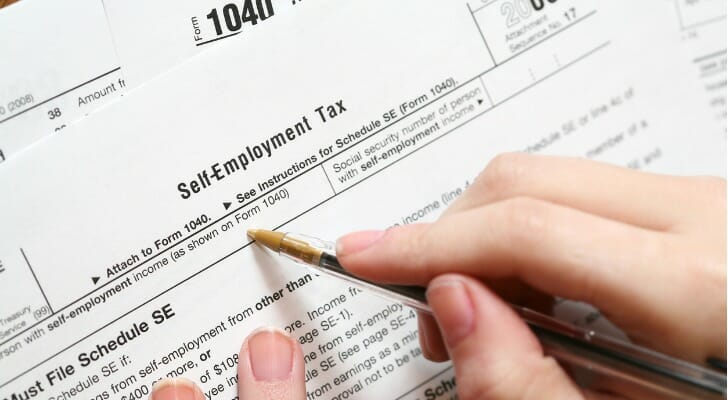If you’re self-employed, you must file quarterly taxes every few months. These are your estimated tax payments, making up for the fact that you don’t have an employer to withhold your taxes over the course of the year. Quarterlies can be a hassle, but skip them and you’ll face a massive tax bill come April. Consider working with a financial advisor as you plan out your taxes and manage your cash flow.
What Are Quarterly Taxes?
Most workers have what is called W-2 income. This means that you earn your income from an employer. When a W-2 employer issues your paycheck, they do three things:
- Withhold that paycheck’s share of income taxes
- Withhold that paycheck’s share of payroll taxes
- Pay the employer’s share of payroll taxes
This means that over the course of the year, W-2 workers steadily pay their taxes with every paycheck. It’s also why, when tax season comes around, most people get money from the IRS. They’ve been steadily making payments all year and are just now getting back the amount they overpaid.
The contrast to this is freelancers, contractors (known as 1099 workers, based the tax form they fill out), small business owners and anyone else who is self-employed. Self-employed workers receive all their paychecks pretax. That can create a pretty hefty bill come mid-April, when none of the taxes have yet been paid.
Payroll taxes come to a flat tax of about 16% applied equally to all income up to $147,000. After this cap they fall off entirely. For a W-2 employee, the worker pays half of this tax and the employer pays the other half. Someone who is self-employed has no employer, so they pay the entire tax on their own. This is known as the self-employment tax.
When to Pay Quarterly Taxes

Income taxes are structured to give the government a steady stream of income over the course of the year. For employees, those taxes are generally deducted every two weeks and sent to the Treasury, which uses the money to fund its operations. Since the self-employed don’t have an employer to do this, the IRS requires what are known as “Quarterly Estimated Taxes.” For 2022, the estimated tax deadlines are as follows:
- First Quarter (all income earned January through March): April 18, 2022
- Second Quarter (all income earned April through June): June 15, 2022
- Third Quarter (all income earned July through September): Sept. 15, 2022
- Fourth Quarter (all income earned October through December): Jan. 15, 2023
At the end of each quarter you pay an estimated amount of tax that you owe from the previous quarter. It is important to note that in April of each year you must pay both annual income taxes and first quarter estimated taxes. Be careful, as many self-employed individuals miss this.
How to Calculate Your Quarterly Taxes
You can calculate quarterly taxes in two ways. Here’s a breakdown of each:
- The more time consuming, but more accurate, method is to calculate your earnings over the past quarter, calculate your anticipated earnings in the total year and apply the appropriate tax rate to your quarter’s earnings based on your anticipated earnings.
- The faster, but potentially less accurate, method is to start with either your anticipated earnings from the current year or your actual earnings from the previous year. Divide that amount by four to represent one quarter’s worth of income and apply the appropriate tax rate for that amount of annual income.
Your estimated taxes account for your total revenue, so this means income after qualifying expenses. If you calculate rather than estimate your earnings you can reduce your income by any amount that you intend to claim as a business expense for that quarter. However, you can only apply that reduction for the quarter in which the expenses happened.
Quarterly taxes include both income taxes and self-employment taxes. Individuals pay this tax using Form 1040 ES.
The IRS assesses an underpayment penalty if you fail to pay your estimated taxes over the course of the year. Underpayment penalties are added when you calculate your final tax bill in April. They apply if, over the course of the year, the estimated taxes that you paid came to less than 90% of your total taxes owed. Underpayment penalties vary based on the amount owed and your tax history and usually come to around 1% of the final bill, but are waived if you paid your full tax bill in the previous year.
What to Watch Out For
If a business wants to hire someone for either full-time or steady work, they must do so through W-2 employment. However, sometimes businesses to hire workers while misclassifying them as freelancers or contractors. This allows employers to pass on their share of payroll taxes to you, the worker. It effectively increases your tax bill by about 8% while reducing theirs by the same amount.
If this describes your current job, reach out to the IRS; your employer may owe you back taxes.
Bottom Line

Quarterly estimated taxes are taxes that the self-employed must pay approximately every three months. They make up for the income taxes that W-2 workers have withheld from their paychecks. While easy to miss, paying your estimated taxes is essential for all self-employed workers.
Tips on Taxes
- Taxes can be complicated, especially for the self-employed. That’s where a financial advisor can be very helpful. Finding a qualified financial advisor doesn’t have to be hard. SmartAsset’s free tool matches you with up to three financial advisors who serve your area, and you can interview your advisor matches at no cost to decide which one is right for you. If you’re ready to find an advisor who can help you achieve your financial goals, get started now.
- Use SmartAsset’s no-cost income tax calculator to get a quick estimate of what you will owe the federal government.
Photo credit: ©iStock.com/AsiaVision, ©iStock.com/SDI Productions, ©iStock.com/adamkaz
